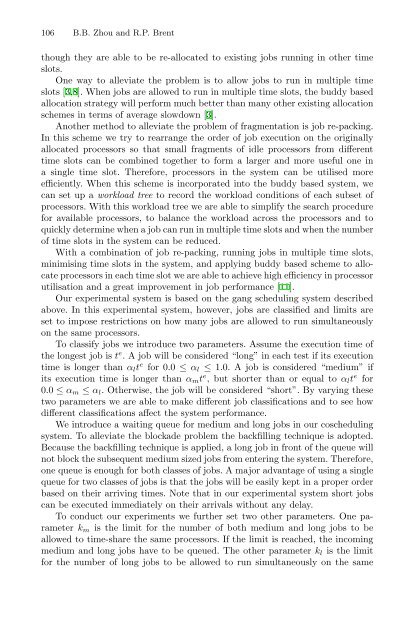LNCS 0558 -Job Scheduling Strategies for Parallel Processing
LNCS 0558 -Job Scheduling Strategies for Parallel Processing
LNCS 0558 -Job Scheduling Strategies for Parallel Processing
You also want an ePaper? Increase the reach of your titles
YUMPU automatically turns print PDFs into web optimized ePapers that Google loves.
106 B.B. Zhou and R.P. Brent<br />
though they are able to be re-allocated to existing jobs running in other time<br />
slots.<br />
One way to alleviate the problem is to allow jobs to run in multiple time<br />
slots [3,8]. When jobs are allowed to run in multiple time slots, the buddy based<br />
allocation strategy will per<strong>for</strong>m much better than many other existing allocation<br />
schemes in terms of average slowdown [3].<br />
Another method to alleviate the problem of fragmentation is job re-packing.<br />
In this scheme we try to rearrange the order of job execution on the originally<br />
allocated processors so that small fragments of idle processors from different<br />
time slots can be combined together to <strong>for</strong>m a larger and more useful one in<br />
a single time slot. There<strong>for</strong>e, processors in the system can be utilised more<br />
efficiently. When this scheme is incorporated into the buddy based system, we<br />
can set up a workload tree to record the workload conditions of each subset of<br />
processors. With this workload tree we are able to simplify the search procedure<br />
<strong>for</strong> available processors, to balance the workload across the processors and to<br />
quickly determine when a job can run in multiple time slots and when the number<br />
of time slots in the system can be reduced.<br />
With a combination of job re-packing, running jobs in multiple time slots,<br />
minimising time slots in the system, and applying buddy based scheme to allocate<br />
processors in each time slot we are able to achieve high efficiency in processor<br />
utilisation and a great improvement in job per<strong>for</strong>mance [11].<br />
Our experimental system is based on the gang scheduling system described<br />
above. In this experimental system, however, jobs are classified and limits are<br />
set to impose restrictions on how many jobs are allowed to run simultaneously<br />
on the same processors.<br />
To classify jobs we introduce two parameters. Assume the execution time of<br />
the longest job is t e . A job will be considered “long” in each test if its execution<br />
time is longer than αlt e <strong>for</strong> 0.0 ≤ αl ≤ 1.0. A job is considered “medium” if<br />
its execution time is longer than αmt e , but shorter than or equal to αlt e <strong>for</strong><br />
0.0 ≤ αm ≤ αl. Otherwise, the job will be considered “short”. By varying these<br />
two parameters we are able to make different job classifications and to see how<br />
different classifications affect the system per<strong>for</strong>mance.<br />
We introduce a waiting queue <strong>for</strong> medium and long jobs in our coscheduling<br />
system. To alleviate the blockade problem the backfilling technique is adopted.<br />
Because the backfilling technique is applied, a long job in front of the queue will<br />
not block the subsequent medium sized jobs from entering the system. There<strong>for</strong>e,<br />
one queue is enough <strong>for</strong> both classes of jobs. A major advantage of using a single<br />
queue <strong>for</strong> two classes of jobs is that the jobs will be easily kept in a proper order<br />
based on their arriving times. Note that in our experimental system short jobs<br />
can be executed immediately on their arrivals without any delay.<br />
To conduct our experiments we further set two other parameters. One parameter<br />
km is the limit <strong>for</strong> the number of both medium and long jobs to be<br />
allowed to time-share the same processors. If the limit is reached, the incoming<br />
medium and long jobs have to be queued. The other parameter kl is the limit<br />
<strong>for</strong> the number of long jobs to be allowed to run simultaneously on the same
















